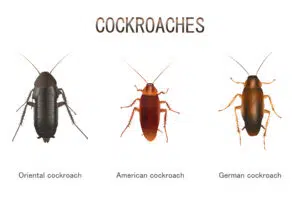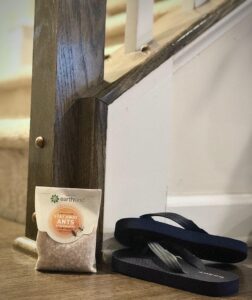What Cockroaches Like to Eat and What Attracts Them To Your Home
By : Rita Stadler
Cockroaches, those resilient and unwelcome guests, have been household pests for centuries. Their presence can be both unsettling and unhygienic. From spreading germs and bacteria, to triggering asthma and allergies, these pests are horrible housemates. To effectively combat these resilient intruders, it’s crucial to understand what they eat and what draws them into our homes.
Understanding Their Diet for Effective Pest Control
Before delving into the specifics of a cockroach’s diet, let’s emphasize why this knowledge is vital for effective pest control. Cockroaches are notorious survivors, and their diet plays a significant role in their ability to thrive in our homes. By learning about their dietary preferences, we can adopt strategies to deprive them of their sustenance, making our homes less attractive to these pests.
The Omnivorous Diet of Cockroaches
Cockroaches are opportunistic feeders, which means they will eat almost anything they can find. Their omnivorous diet allows them to adapt and survive in diverse environments.
In the wild, cockroaches primarily consume organic matter like leaves, wood, and decomposing plant material. However, when they infiltrate our homes, their diet expands to include a variety of human-made and natural substances.
These insects play a crucial role as scavengers in ecosystems. They help break down decaying matter and recycle nutrients. Unfortunately, this scavenging behavior often leads them to our homes in search of an easy meal.
Common Food Sources: Organic Matter, Food Crumbs, and Dead Insects
Cockroaches are not picky eaters. They will feast on food crumbs, leftovers, and even dead insects they come across in our homes. Watch out for things that may attract or harbor roaches such as piles of yard debris, compost, overflowing or uncovered trash bins, and even cardboard boxes used for storage.
Foods That Attract Cockroaches Most
Understanding the specific foods that attract cockroaches the most is essential for prevention. Here are some of their favorite foods:
- Sugary Foods and Why Roaches Love Them: These pests are known to have a sweet tooth and are particularly drawn to sugary substances. This includes spilled soda, syrup, and even the residue on unwashed dishes.
- Starchy Foods: From Cardboard Boxes to Book Bindings: Starches like cardboard boxes and book bindings are susceptible to cockroach infestations. The glue used in these materials can be a food source for these pests.
- Greasy Foods and Their Appeal: Cockroaches are also attracted to greasy, oily foods. Pizza boxes or greasy stovetops can provide a hearty meal for them.
- Human Food Items That Are Roach Magnets: These pests will feast on a wide range of human foods, from cereals to bread. They can infiltrate your pantry and contaminate your food supply.
Surprising Items They May Eat
Cockroaches’ eclectic diet goes beyond what we typically associate with food:
- Cockroaches and Non-Food Items: Wallpaper Glue, Toothpaste, and Soap: These pests can consume non-food items such as wallpaper glue, toothpaste, and soap, making personal hygiene items potential sources of infestation.
- Do Cockroaches Really Eat Feces, Dead Skin, and Hair?: Cockroaches are known to scavenge dead skin flakes, hair, and even feces, contributing to their reputation as unhygienic pests.
- Other Bugs, Such as Bed Bugs, Ants, and Spiders: In desperate times, these pests may resort to cannibalism, consuming other insects like bed bugs, ants, and spiders.
Cockroach Species and Their Preferences
Different cockroach species have unique dietary preferences. Understanding these variations can help identify and control infestations effectively.
- American Cockroaches: Specifics in Their Diet Like Organic Matter: American cockroaches favor organic matter, decaying plant material, and food scraps.
- German Cockroaches: Specifics in Their Diet: German cockroaches are notorious kitchen invaders and prefer sugary, starchy, and greasy foods.
- Oriental and Brown-Banded Cockroaches: Specifics in Their Diet: Oriental and brown-banded cockroaches exhibit unique dietary habits, often consuming items like wallpaper and fabrics.
Cockroaches in the Wild vs. In Your Home
Understanding the natural habitats of these insects and how they adapt to our homes is crucial for effective pest control.
Cockroaches typically inhabit environments like sewers, leaf litter, and dead trees before making their way into our homes.
Homeowners may unknowingly create ideal conditions for an infestation by leaving food sources readily available. Taking action to quickly clean up spills, keep your sink free from dirty dishes, and using a covered trash can will go a long way in preventing pests.
Cockroach infestations in a home can pose health risks due to the allergens they produce. Their droppings can also carry bacteria, so recognizing the signs of their presence and taking swift action to eliminate these pests is essential.
How Long Can Cockroaches Survive Without Food?
Cockroaches are incredibly resilient creatures, capable of surviving extended periods without food. They can survive without food for weeks, depending on their species and environmental conditions.
Their remarkable adaptability includes the ability to enter a state of dormancy when resources are scarce. This adaptability, combined with their long lifespan, makes them particularly challenging pests to manage.
While cockroaches can survive without food for a while, they require water more frequently. Addressing potential water sources around the home is another critical aspect of pest control.
Consider Cruelty-Free and Environmentally Friendly Pest Control
For those wondering how to get rid of cockroaches, consider humane pest control methods that do not harm the environment, such as EarthKind’s Stay Away Ants & Cockroaches. Choosing eco-friendly solutions to use around the home prevents accidental poisoning of pets and unintended animals. You’ll also avoid concerns about bringing harmful chemicals into your home while maintaining the delicate balance of your indoor and outdoor ecosystems.
To keep your home free from cockroach infestations, follow these preventative measures:
- Keeping Countertops Clean and Free From Food Crumbs: Regularly clean countertops and kitchen surfaces to remove food crumbs and spills.
- Storing Food in Airtight Containers: Store food in airtight containers to deny access to cockroaches.
- Addressing Other Attractions: Dirty Dishes, Pet Food, and Cardboard Boxes: Ensure dirty dishes are promptly washed, and pet food is not left out overnight. Cockroaches are also attracted to cardboard boxes, so keep clutter to a minimum.
When to Call a Pest Control Company or Exterminator
If the infestation is severe or persists despite your efforts, it’s wise to seek a professional for effective cockroach control assistance.
Keeping a Pest-Free Home
Understanding what cockroaches like to eat and what attracts them to your home is essential for maintaining a pest-free living environment. By adopting proactive measures and humane pest control methods, you can ensure that your home remains an unwelcoming place for these resilient pests.
For a naturally smarter pest control solution, try EarthKind’s Stay Away Ants & Cockroaches deterrent pouches. To find a store near you, visit the Store Locator. Keep your home safe, sustainable, and pest-free.









 day
day